

|
Fri16 Sep10:35am(15 mins)
|
Where:
Ken Wade
Session:
Speaker:
|
The chemical modification of cysteine residues with small molecules has become cornerstone in the modulation of drug-relevant targets in chemical biology and drug discovery. Protein tyrosine phosphatases (PTPs) of bacterial origin often display a poorly conserved, non-catalytic cysteine (Cys) within range of the conserved active site. While mainstream target-based discovery programs aim at the inactivation of catalytically essential residues, target modulation through accessible and highly active non-catalytic Cys residues constitutes an emerging paradigm in chemical biology and molecular medicine. Herein, we disclose a post-translational chemical editing method to install dehydroalanine (Dha), without prior alteration of enzyme amino acid sequence or deleterious enzyme inactivation, in a non-catalytic Cys with exquisite regioselectivity. Unexpectedly, we unveiled a long-range dynamic interplay between the backdoor and catalytic Cys residues, as exemplified with the Mycobacterium tuberculosis virulence factor protein tyrosine phosphatase A (PtpA) and Yersinia enterocolitica tyrosine phosphatase YopH. Our findings suggest an alternative mechanism of redox regulation in bacterial PTPs and provide a solid rationale for designing effective and innovative antimicrobial PTP-targeting chemical probes.